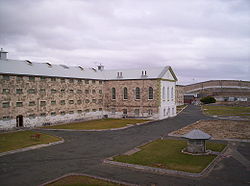
Punishment in Australia arises when an individual has been accused or convicted of breaking the law through the Australian criminal justice system. Australia uses prisons, as well as community corrections (various non-custodial punishments such as parole, probation, community service etc.).[1] When awaiting trial, prisoners may be kept in specialised remand centres or within other prisons.
The death penalty has been abolished,[2] and corporal punishment is no longer used.[3] Prison labour occurs in Australia, with prisoners involved in many types of paid work. Before the colonisation of Australia by Europeans, Indigenous Australians had their own traditional punishments, some of which are still practised.[4] The most severe punishment by law which can be imposed in Australia is life imprisonment. In the most extreme cases of murder, and some severe sex offences, such as aggravated rape, courts in the states and territories can impose life imprisonment without parole, thus ordering the convicted person to spend the rest of their life in prison.
Prisons in Australia are operated by state-based correctional services departments, for the detention of minimum, medium, maximum and supermax security prisoners convicted in state and federal courts, as well as prisoners on remand. In the June quarter of 2024, there were 44,403 adults imprisoned in Australia, which represents an incarceration rate of 208 prisoners per 100,000 adult population,[5] or 172 per 100,000 total population.[6] This represents a sharp increase from previous decades.[7] In 2016-2017 the prison population was not representative of the Australian population, for example, 91% of prisoners were male,[8] while males were only half of the population, and 27% of prisoners were Aboriginal or Torres Strait Islanders,[8] while Indigenous people were only 2.8% of the population.[9] In 2018, 18.4% of prisoners in Australia were held in private prisons.[8]
In the 2016-17 financial year, Australia spent $3.1 billion on prisons and $0.5 billion on community corrections.[10]
Australia also detains non-citizens in a separate system of immigration detention centres, operated by the federal Department of Home Affairs, pending their deportation and to prevent them from entering the Australian community.[11] Controversially this includes the detention of asylum seekers, including children, while their claims to be refugees are determined.[12][13] In 2023, the High Court of Australia ruled that indefinite detention was unconstitutional if the detainees had no foreseeable prospect of deportation (for instance stateless individuals). The court stated that in such cases indefinite detention amounted to punishment, which is the purview of the courts - not the executive government.[14] It has been stated the different purposes make little practical difference between immigration detention and imprisonment,[15] and that detainees often experience immigration detention as if it were punishment.[16]
- ^ "Managing offenders in the community". New South Wales Government. Retrieved 12 November 2018.
- ^ "Capital Punishment in Australia". National Library of Australia. Archived from the original on 5 November 2018. Retrieved 5 November 2018.
- ^ "Cop sees the sense in lashing out as corporal punishment". The Herald Sun. 20 March 2014. Retrieved 12 November 2018.
- ^ Jens, Korff (23 February 2020). "Tribal punishment, customary law & payback". Creative Spirits.
- ^ "Prisoners in Australia, 2024". Australian Bureau of Statistics. Retrieved 19 December 2024.
- ^ "Highest to Lowest - Prison Incarceration Rate". World Prison Brief. Retrieved 12 November 2018.
- ^ "Corrective Services Australia" (PDF). Australian Bureau of Statistics. June 1998. Retrieved 12 November 2018.
- ^ a b c "Report on Government Services 2018". Productivity Commission. 25 January 2018.
- ^ "Census of Population and Housing: Reflecting Australia - Stories from the Census, 2016". Australian Bureau of Statistics. Retrieved 12 November 2018.
- ^ "8 Corrective Services" (PDF). Productivity Commission. Retrieved 12 November 2018.
- ^ Dillon, Sarah (8 November 2013). "Immigration detention and human rights". www.humanrights.gov.au. Australian Human Rights Commission. Retrieved 13 November 2018.
- ^ "All children to be off Nauru by year's end". The Sydney Morning Herald. 1 November 2018.
- ^ Doherty, Ben (17 May 2016). "Australia's indefinite detention of refugees illegal, UN rules". The Guardian.
- ^ . University of Melbourne. December 2023 https://law.unimelb.edu.au/__data/assets/pdf_file/0006/4818858/Stateless-people-in-Australia-after-the-High-Court-ruling_Dec-2023.pdf. Retrieved 8 November 2024.
{{cite web}}: Missing or empty|title=(help) - ^ Groves, M (2004). "Immigration detention vs imprisonment: Differences explored". Alternative Law Journal. doi:10.1177/1037969X0402900505. S2CID 147807434. (2004) 29(5) Alternative Law Journal 228.
- ^ Turnbull, S (March 2017), "Immigration Detention and Punishment", Oxford Research Encyclopedia of Criminology and Criminal Justice, doi:10.1093/acrefore/9780190264079.013.231, ISBN 9780190264079
